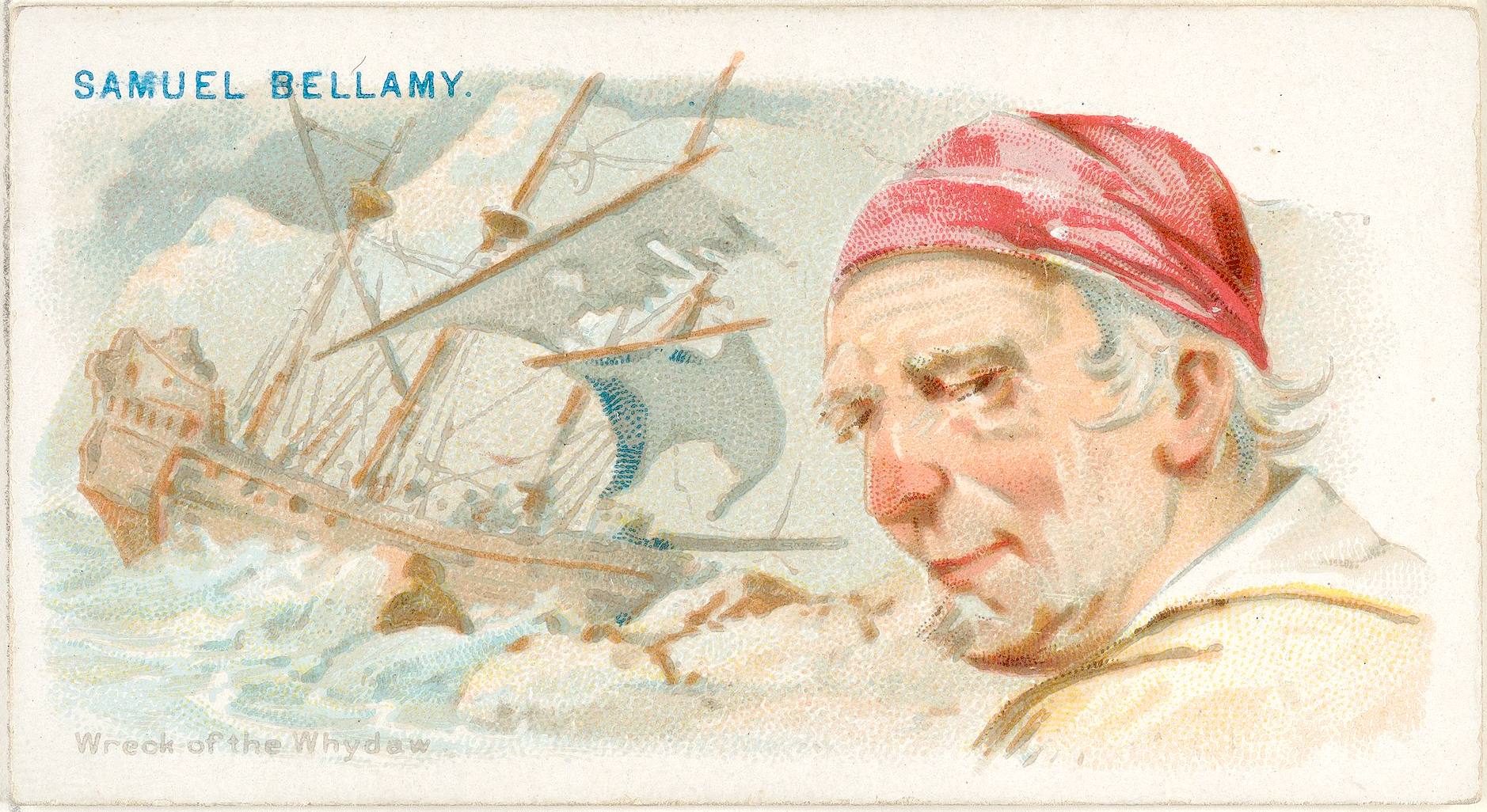
Captain
Samuel Bellamy, known as Black Sam
Captain Samuel Bellamy (c. February 23, 1689 – April 26, 1717), later known as "Black Sam" Bellamy, was an English
pirate who operated in the early 18th century. He is best known as the wealthiest pirate in recorded history, and one of the faces of the Golden Age of Piracy. Though his known career as a pirate captain lasted little more than a year, he and his crew captured at least 53 ships. Called "Black Sam" in Cape Cod folklore because he eschewed the fashionable powdered wig in favor of tying back his long black hair with a simple band, Bellamy became known for his mercy and generosity toward those he captured on his raids. This reputation earned him another nickname, the "Prince of Pirates". He likened himself to Robin Hood, with his crew calling themselves "Robin Hood's Men".
Bellamy was born in England in 1689, and began sailing for the British Royal Navy as a teenager. After traveling to Cape Cod around 1715, he then went south to the Florida coast in an effort to locate a sunken treasure fleet. From there he made his way to the Bahamas, sailing under
Benjamin Hornigold and his second-in-command,
Edward
Teach. After Hornigold and Teach were voted out of command, Bellamy took a captured vessel as his own, before capturing a state-of-the-art slave trade ship, the Whydah Gally, in the early spring of 1717. Two months later, the vessel was caught in a nor'easter storm off the coast of Massachusetts and sank, taking Bellamy and most of his crew down with it. The remains of the Whydah Gally were discovered in 1984, making it the first authenticated pirate ship discovered in North America.
SHIPWRECKED
Just two months after acquiring the Whydah, as she and the Marianne approached Cape Cod, Williams told Bellamy that he wished to visit his family in Rhode Island, and the two agreed to meet up again near Maine. Bellamy and the Whydah captured several other small vessels in the area, including the Anne Galley, to which he appointed his quartermaster Richard Noland as captain.
If Bellamy intended to revisit his lover Maria Hallett, he failed. The Whydah was swept up in a violent nor'easter storm off Cape Cod at midnight, on April 26, 1717, and was driven onto the sand bar shoals in 16 feet of
water some 500 feet from the coast of what is now Wellfleet, Massachusetts. At 15 minutes past midnight, the masts snapped and drew the heavily loaded ship into 30 feet of water where she capsized and quickly sank, taking Bellamy and all but 2 of the Whydah's 146-man crew with her.
104 bodies were known to have washed ashore and were buried by the town coroner, leaving 42 bodies unaccounted for. The Mary Anne was also wrecked that night several miles south of the Whydah, leaving 7 more survivors. All 9 survivors from the two ships were captured and prosecuted for piracy in Boston, and 6 were convicted on October 22, 1717 and hanged on November 15. (King George's pardon of all pirates, issued on September 5, supposedly arrived in Boston 3 weeks too late). 2 were set free, the court believing their testimony that they had been forced into piracy. The last, a 16-year-old Miskito Indian from Central America, John Julian, was believed to have been sold into slavery to John Quincy, the great-grandfather of U.S. President John Quincy Adams.
LEGACY
In July 1984, Bellamy became famous again when the discovery of the wreckage of his flagship Whydah was announced, and would soon become the first authenticated pirate shipwreck ever discovered in North America. At the time of its sinking, the Whydah was the largest pirate prize ever captured, and the treasure in its hold amassed roughly 4.5 to 5 tons, including huge quantities of indigo, ivory,
gold, and 20,000 to 30,000 pounds sterling, divided into 180 sacks of 50-pound (23 kg) each. The discovery of the wreck was made in 1982 by a diving crew led and funded by underwater explorer Barry Clifford.
The vessel was under just 14 feet (4.3 m) of water and 5 feet (1.5 m) of sand.
In 1985, Clifford recovered the ship's bell upon which were the words "THE WHYDAH GALLY 1716", the first incontrovertible evidence of his find. He subsequently founded The Whydah Pirate Museum on MacMillan Wharf in Provincetown, Massachusetts, dedicated to Bellamy and the Whydah. It houses many artifacts which were brought from the actual wreck, including a cannon found to be stuffed with precious stones, gold and artifacts. A portion of the some 200,000 artifacts so far recovered are currently on a six-year tour around the United States under the sponsorship of the National Geographic Society. From May 2017 through July 30, 2017, it was at the Portland Science Center in Portland, Maine.
Suspected remains of Bellamy were found near the wreck of his ship, in February 2018. The bones were near a pistol identified as his, and DNA tests were carried out with a living relative to confirm. In May 2018, tests confirmed that the bones were of an Eastern European man, though not Bellamy.
In February 2021, Clifford announced six more pirates' bones were discovered in concretements of debris, and will be tested for DNA matches once they are extracted.
Please use our
A-Z INDEX to
navigate this site
